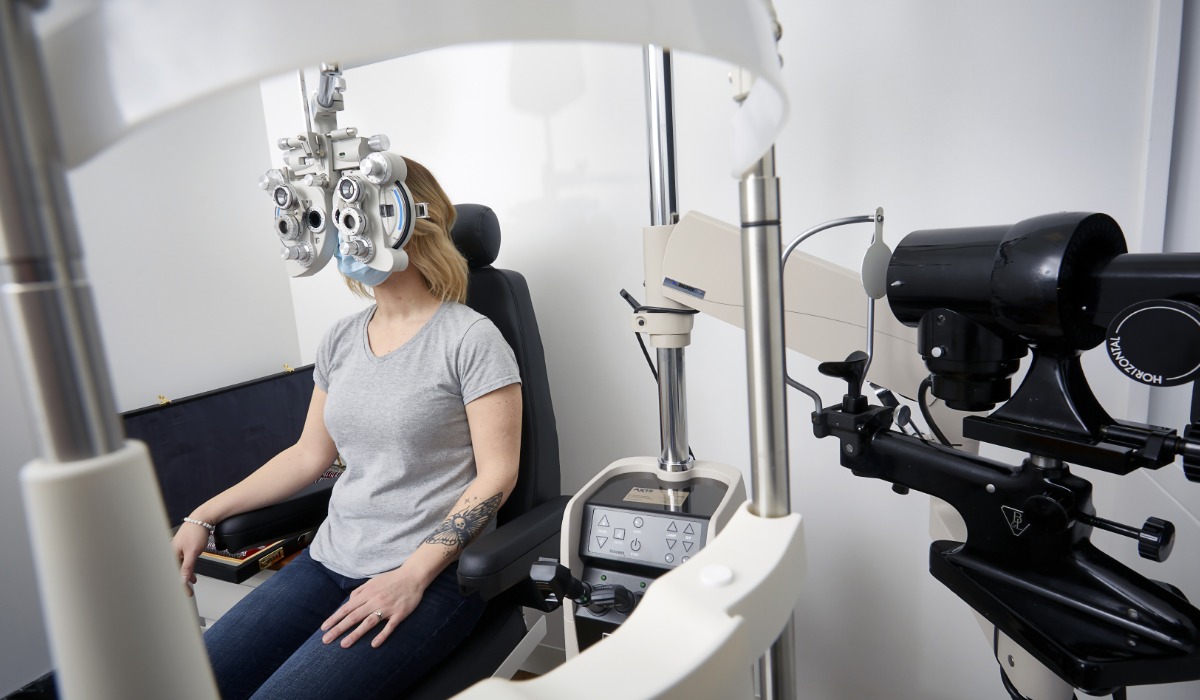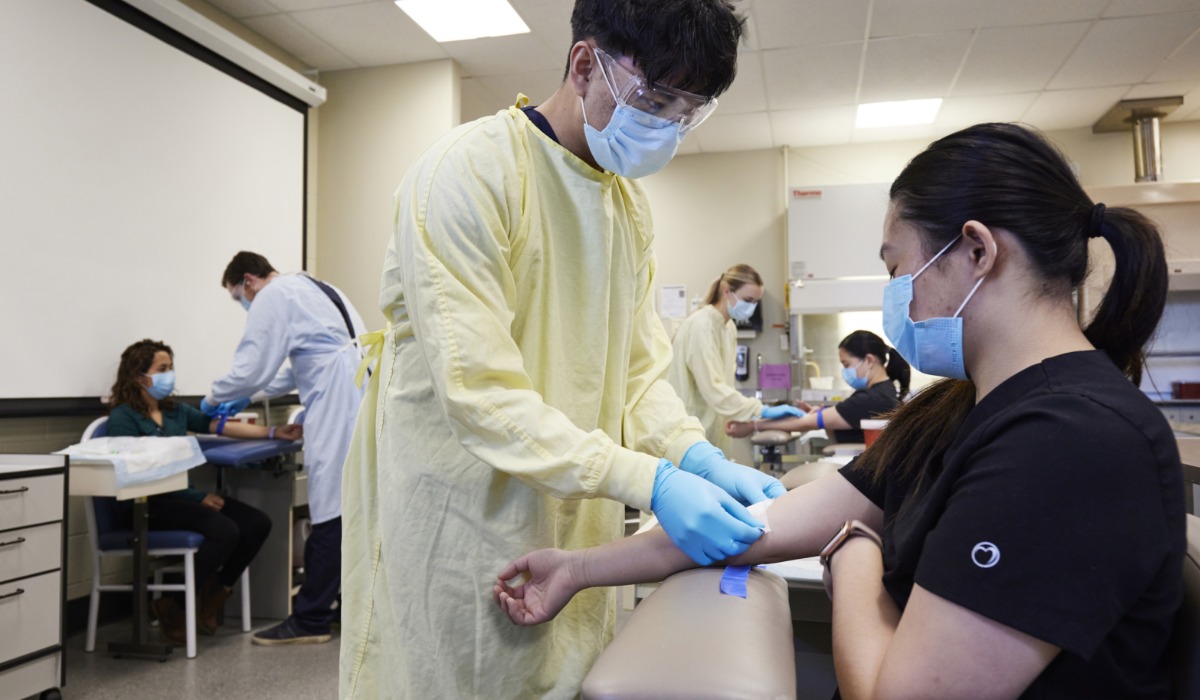Overview
This program equips you with the essential skills to support eye care professionals, including ophthalmologists, optometrists and opticians.
As a student, you will:
- learn the key medical and scientific principles of eye care
- gain expertise in optimal eye health and vision care terminology and procedures
- engage in a mix of classroom theory, hands-on lab practice and a clinical practicum
- obtain unique skill sets that prepare you for two professions (ophthalmology and optometry) within one program.
Graduates can pursue careers as assistants in diverse medical settings, including private eye care clinics, corporate eye care practices and surgical eye centres.

How will you start at SAIT? See how three students chose a career fit for them
TJ, Luc and Hannah found their way to SAIT for different reasons and with different career aspirations — and so can you.
Those in ophthalmic and optometric assisting tend to be methodical, social and objective.
You need:
- to be organized
- effective communication skills
- the ability to work independently or with others
- to work well under stress, maintain professional behaviour and regulate your emotions
- patience and a courteous, pleasant manner
- critical thinking skills
- the ability to interact confidently and instil confidence in patients
- a high regard for patient confidentiality
- fine motor skills and good vision (with or without corrective lenses).
Ophthalmic and optometric assistants may wear personal protective equipment (PPE) for long periods, which includes exposure to latex and disinfection materials.
They also need to be able to meet the physical demands of the job, which can include spending most of their working hours on their feet and performing repetitive tasks.
You may work extended hours and shift work, including nights and weekends.
You are strongly encouraged to refer to the ALIS website for career, learning, and employment information for ophthalmic medical personnel to ensure you can successfully meet the occupational requirements for the program and profession.
Graduates of this certificate program meet the admission requirements to enter SAIT's Optician diploma.
The curriculum aligns with the first semester of study for the diploma, so you can earn your diploma with an additional year and a half of study.
You will complete a required practicum in either an ophthalmology or optometry clinic.
You will be assigned practicum placements with consideration given to your preference of location. However, due to limited availability in Calgary, it might be necessary for you to travel or relocate outside the city.
The healthcare field has a strong focus on health, wellness, and fitness to practice due to the demanding nature of the work and Occupational Health and Safety requirements. As such, special considerations will not be granted based on individual circumstances or preferences, except those stated as protected grounds when an accommodation has been approved.
In compliance with the practica agreements with our clinical partners, you will be required to provide specific documentation before you can participate in your practicum. Find out what requirements you need for this program.
Our Ophthalmic and Optometric Assisting program provides entry-level certification, and is aligned with the competencies outlined by the Joint Commission on Allied Health Personnel in Ophthalmology (JCAHPO) guidelines.
Upon successful completion of this program, you'll be awarded a SAIT Ophthalmic and Optometric Assisting certificate.
Careers and opportunities
Each year, SAIT conducts a survey between February and April to determine the employment rate, salary and satisfaction of our newest SAIT alumni.
![]() 91% graduate employment rate
91% graduate employment rate
![]() $37,110 average starting salary
$37,110 average starting salary
Find out more about our graduate employment statistics >
Our graduates may work in the following occupations. Some careers require additional experience and education.
Associated National Occupational Classification (NOC) codes: 32109, 33109.
Career planning support
Unsure which career path is for you? Here are some recommended career planning resources to help you decide your future.
You can also head to Alberta alis for lots of information about careers in Alberta, including quizzes and labour market information to help you narrow down a path.
Finally, you can take our online career finder quiz, which can help narrow your options based on your current skills and interests.
Courses
The Ophthalmic and Optometric Assisting certificate requires 27 credits (nine courses) to complete.
The program spans one year, with two semesters.
| Course | Credits |
|---|---|
|
This course introduces the structure of the different systems within the human body and describes how those systems work together to maintain homeostasis and keep the body alive. You will identify anatomical parts and describe the organization and relationships between chemical units, cellular components, tissues, organs and systems. |
3 |
|
This course covers all aspects of ophthalmic and optometric skills, with hands-on practice to develop your technical skills. This course combines theory in the pre-lab activities with labs designed to reinforce the material. The labs will provide experience with all the technical skills required to become an ophthalmic/optometric assistant. This includes obtaining case history and assessment of visual acuities to performing diagnostic testing along with insertion and removal of contact lenses. You will also make eyeglass adjustments and provide follow-up care to your patients. Pre-requisites:
One of:
|
3 |
|
Ocular anatomy and physiology is the cornerstone of ophthalmic medical technology. This course covers ocular diseases, syndromes and disorders that could be understood through a strong base in anatomy and physiology of the eye. |
3 |
|
This course introduces principles and standards pertaining to clinical procedures in eye care. These include ethics, legislation, professional regulation, job roles, teamwork, and professionalism. |
3 |
|
This course focuses on the testing and instrumentation used in an ophthalmic medical setting. This course will provide the learners with knowledge of testing as a diagnostic tool, as well as equip them with technical knowledge necessary to troubleshoot, maintain, and repair equipment. Pre-requisites:
One of:
|
3 |
|
This course introduces ophthalmic concepts that directly pertain to patient care. This includes: pretesting and supplementary testing, eyewear frames and lenses, contact lenses, refraction and ocular health, removal or application of eye dressings, business and retail, office procedures, and assisting disabled adults and child patients. |
3 |
|
This course will teach the learners the foundations of assisting in ophthalmic surgical procedures. This includes surgical asepsis, surgical instruments, types of surgeries, and ophthalmic surgical pharmacology. Pre-requisites:
One of:
|
3 |
|
This course will introduce how systemic diseases can have eye implications and must not be overlooked when considering diagnosis of an eye disease or disorder. The course will also focus on medication classifications, safe medication calculations, and safe medication administration, alongside an introduction to common ocular medications and over the counter (OTC) products. |
3 |
|
Learners are provided with the opportunity to rotate through specific clinical settings on a weekly basis, in order to achieve identified clinical objectives required for achieving entry-level competencies as specified by the Joint Commission on Allied Health Personnel in Ophthalmology (JCAHPO) Competency Profile. Pre-requisites:
One of:
Concurrent Prerequisites:
|
3 |
Progression
You must attain a PGPA and/or a CGPA of 2.0 or better each semester and pass the prerequisite courses to progress through the program.
To qualify for graduation, you must pass all courses, attain a CGPA of 2.0 or better and complete course requirements within the prescribed timelines.
Admission requirements
Applicants educated in Canada
All applicants must demonstrate English language proficiency and meet the following requirements or equivalents:
- at least 60% in English Language Arts 30-1 or English Language Arts 30-2, and
- at least 60% in Math 30-1 or Math 30-2, and
- at least 60% in Biology 30 or Science 30.
SAIT accepts high school course equivalents for admission for applicants educated outside Alberta.
All applicants who were educated outside of Canada must demonstrate English language proficiency and provide proof they meet the program admission requirements outlined above with an international document assessment. Find accepted educational documents and assessment options.
SAIT may also accept courses completed at certain international post-secondary institutions.
Academic Upgrading
Missing an admission requirement for this program? Upgrade your prior education to help you receive admission into one of SAIT's career programs.
English language proficiency
All applicants must demonstrate English language proficiency prior to admission, including students educated in Canada.
Transfer agreements
At SAIT, we have created transfer agreements with partner institutions to allow you to earn course credits toward your SAIT program based on your previously completed credentials.
Transfer Alberta search tool
Use the Transfer Alberta search tool to see all transfer agreements between Alberta post-secondary institutions (including those with the University of Calgary, Mount Royal University and Bow Valley College.)
Search transfer agreements in Alberta
Transfer options for graduates
When you have completed this program, you may continue your education at a partner post-secondary institution. These transfer agreements include partnerships within and/or outside of Canada.
Available intakes
Winter 2026
Start dates:
- Domestic students: Closed
-
-
Application deadline:
-
- International students: Closed
-
-
Application deadline:
-
Fall 2026
Start dates:
- Domestic students: Open
-
-
Application deadline: June 30, 2026
-
- International students: Open
-
-
Application deadline: May 29, 2026
-
Winter 2027
Start dates:
- Domestic Students (apps open March 1, 2026): Closed
-
-
Application deadline: Oct. 23, 2026
-
- International students: Open
-
-
Application deadline: Oct. 9, 2026
-
Costs
2025/26 tuition and fees
The following estimated costs are effective as of July 1, 2025.
The estimated total cost of tuition and fees is based on the suggested schedule of study. Following a modified schedule will impact the fees you pay per semester and may alter final costs.
Domestic students
The program total is based on the estimated amount you will pay if you enter this program during the 2025/26 academic year. The program total amount listed on your letter of admission may appear higher. This amount is your maximum tuition guarantee for the program. SAIT will not exceed this maximum, regardless of changes in tuition and fees between academic years.
Books and supplies are approximately $1,200 per full-time year.
An Apple or Android laptop is required. This is a bring-your-own-device program with a standard computer hardware and software requirement. See the specific requirements on our computers and laptops page. Tablets or mobile phones are not suitable alternatives.
Find your booklist on the SAIT Bookstore's website. Booklists are created by semester and available approximately two weeks before classes begin.
Required personal protective equipment (PPE) and uniforms
You will require:
- navy scrubs (pants and top)
- closed-toe water-impermeable shoes.
Additional industry-approved PPE will be discussed before the start of labs.
Additional fees
- You are responsible for additional expenses related to your practicum, including pre-practicum requirements and relocation costs to practicum sites outside of Calgary.
Financial aid
Paying for your education may feel overwhelming, but we have resources and programs that can help, including information about payment options, student loans, grants and scholarships.
Admission process
Ready to apply?
Follow our step-by-step guide to submitting a successful application.
Communication during admission
Email is the primary source of communication during the admission process. Ensure your personal email account is managed appropriately to receive our emails, files and communications.
We recommend you add hps.info@sait.ca domain to your safe senders' list or you risk missing critical email messages.
Begin your application
Apply now using the online application portal.
Ensure you have a valid Visa or Mastercard to pay the non-refundable application fee of $120 for domestic applicants or $175 for international applicants.
Information sessions
Prepare for a strong start in your chosen program or get the details you need to decide your future path.
Our expert staff and faculty are ready to answer your questions and provide information about the following:
- What sets SAIT apart
- An introduction to the program and area of study
- Admission requirements
- Future career paths
- Information on the earning potential and graduate employment rates.
Contact us
School of Health and Public Safety Advising
-
Email - hps.info@sait.ca
International Student Advising
-
Phone - 403.284.8852
-
Email - international@sait.ca
Subscribe for updates
Your journey starts here! Sign up to get important updates on:
- Health and medical programs
- Application information
- Relevant news and events

Oki, Âba wathtech, Danit'ada, Tawnshi, Hello.
SAIT is located on the traditional territories of the Niitsitapi (Blackfoot) and the people of Treaty 7 which includes the Siksika, the Piikani, the Kainai, the Tsuut’ina and the Îyârhe Nakoda of Bearspaw, Chiniki and Goodstoney.
We are situated in an area the Blackfoot tribes traditionally called Moh’kinsstis, where the Bow River meets the Elbow River. We now call it the city of Calgary, which is also home to the Métis Nation of Alberta.




